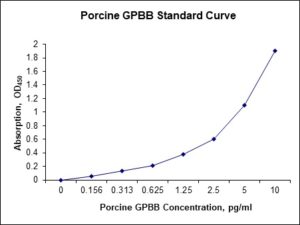Nori Porcine GPBB ELISA Kit
$461.00 – $832.00
This ELISA kit is for quantification of GPBB in pig. This is a quick ELISA assay that reduces time to 50% compared to the conventional method, and the entire assay only takes 3 hours. This assay employs the quantitative sandwich enzyme immunoassay technique and uses biotin-streptavidin chemistry to improve the performance of the assays. An antibody specific for GPBB has been pre-coated onto a microplate. Standards and samples are pipetted into the wells and any GPBB present is bound by the immobilized antibody. After washing away any unbound substances, a detection antibody specific for GPBB is added to the wells. Following wash to remove any unbound antibody reagent, a detection reagent is added. After intensive wash a substrate solution is added to the wells and color develops in proportion to the amount of GPBB bound in the initial step. The color development is stopped, and the intensity of the color is measured.
Alternative names for GPBB: Glycogen phosphorylase isoenzyme BB, PYGB
This product is for Laboratory Research Use Only not for diagnostic and therapeutic purposes or any other purposes.
- Description
- How Elisa Works
- Product Citation (0)
- Reviews (0)
Description
Nori Porcine GPBB ELISA Kit Summary
Alternative names for GPBB: Glycogen phosphorylase isoenzyme BB, PYGB
Alternative names for porcine: pig, swine
| Assay Type | Solid Phase Sandwich ELISA |
| Format | 96-well Microplate or 96-Well Strip Microplate |
| Method of Detection | Colorimetric |
| Number of Targets Detected | 1 |
| Target Antigen Accession Number | F1RQQ7 |
| Assay Length | 3 hours |
| Quantitative/Semiquantitative | Quantitative |
| Sample Type | Plasma, Serum, Cell Culture, Urine, Cell/Tissue Lysates, Synovial Fluid, BAL, |
| Recommended Sample Dilution (Plasma/Serum) | No dilution for sample <ULOQ; sufficient dilution for samples >ULOQ |
| Sensitivity | 30 pg/mL |
| Detection Range | 0.156-10 ng/mL |
| Specificity | Porcine GPBB |
| Cross-Reactivity | < 0.5% cross-reactivity observed with available related molecules, < 50% cross-species reactivity observed with species tested. |
| Interference | No significant interference observed with available related molecules |
| Storage/Stability | 4 ºC for up to 6 months |
| Usage | For Laboratory Research Use Only. Not for diagnostic or therapeutic use. |
| Additional Notes | The kit allows for use in multiple experiments. |
Standard Curve
Kit Components
1. Pre-coated 96-well Microplate
2. Biotinylated Detection Antibody
3. Streptavidin-HRP Conjugate
4. Lyophilized Standards
5. TMB One-Step Substrate
6. Stop Solution
7. 20 x PBS
8. Assay Buffer
Other Materials Required but not Provided:
1. Microplate Reader capable of measuring absorption at 450 nm
2. Log-log graph paper or computer and software for ELISA data analysis
3. Precision pipettes (1-1000 µl)
4. Multi-channel pipettes (300 µl)
5. Distilled or deionized water
Protocol Outline
1. Prepare all reagents, samples and standards as instructed in the datasheet.
2. Add 100 µl of Standard or samples to each well and incubate 1 h at RT.
3. Add 100 µl of Working Detection Antibody to each well and incubate 1 h at RT.
4. Add 100 µl of Working Streptavidin-HRP to each well and incubate 20 min at RT.
5. Add 100 µl of Substrate to each well and incubate 5-30 min at RT.
6. Add 50 µl of Stop Solution to each well and read at 450 nm immediately.
Background:
Glycogen phosphorylase isoenzyme BB (abbreviation: GPBB) is an isoenzyme of glycogen phosphorylase.[1] This isoform of the enzyme exists in cardiac (heart) and brain tissue. The enzyme is one of the “new cardiac markers” which are discussed to improve early diagnosis in acute coronary syndrome.[2-4] A rapid rise in blood levels can be seen in myocardial infarction and unstable angina. GPBB based on its metabolic function is an enzyme for early laboratory detection of ischaemia and infarction.[5] In the aerobic heart muscle GPBB together with glycogen is tightly associated with the vesicles of the sarcoplasmic reticulum. Release of GPBB, the main isoform in the human myocardium, essentially depends on the degradation of glycogen, which is catalyzed by GP. Ischaemia is known to favour the conversion of bound GP in the b form into GP a, thereby accelerating glycogen breakdown, which is the ultimate prerequisite for getting GP into a soluble form being able to move freely in the cytosol. The efflux of GPBB into the extracellular fluid follows if ischaemia-induced structural alterations in the cell membrane become manifest. The clinical application of GPBB as a marker of ischaemic myocardial injury is a very promising tool for extending our knowledge of the severity of myocardial ischaemic events in the various coronary syndromes. GPBB along with cardiac Troponin I elevated after chemotherapy for acute leukemia and thus may serve a potential for detection of acute cardiotoxicity.[6] GPBB concentration measurement may be a useful tool for monitoring myocardial ischemia during a transjugular intrahepatic portosystemic shunts procedure.[7]
References
1. Newgard CB, et al. (1988) J. Biol. Chem. 263 (8), 3850-3857 (1988)
- Apple FS, et al. (2005) Clin. Chem. 51 (5): 810–24.
- Peetz D, et al. (2005). Clin. Chem. Lab. Med. 43 (12): 1351–8.
- Lillpopp L, et al.(2012) Am. J. Cardiol. 110 (9), 1225-1230.
- Krause EG1, (1996) Mol Cell Biochem. 160-161:289-95.
- Horacek JM1, et al. (2010) Exp Oncol. 32(2):97-9.
- Vasatova M1, et al. (2015) Biomed Pap Med Fac Univ Palacky Olomouc Czech Repub. 159(3):437-41.
Be the first to review “Nori Porcine GPBB ELISA Kit”
You must be logged in to post a review.




























Reviews
There are no reviews yet.